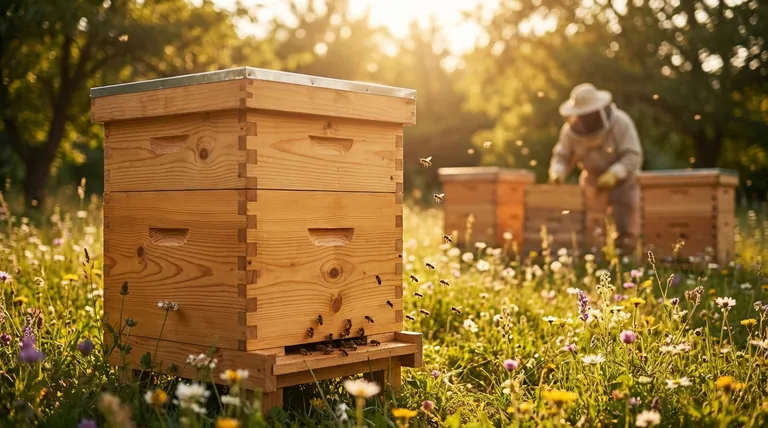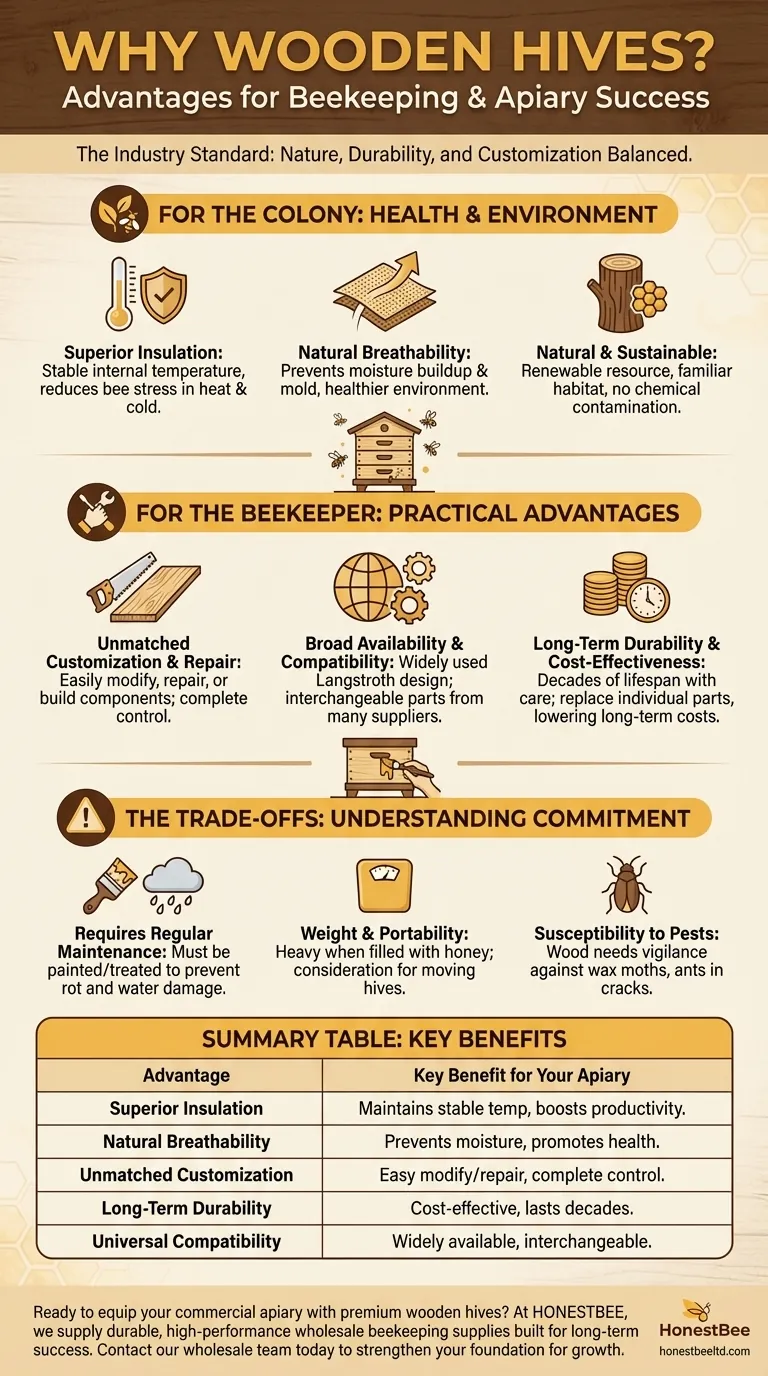At their core, wooden beehives are the industry standard because they offer an exceptional balance of natural insulation, long-term durability, and unmatched customization. Their widespread availability and compatibility make them a practical and reliable choice for beekeepers of all experience levels, providing a healthy environment for bees and a flexible system for management.
The decision to use wooden hives is less about a single advantage and more about choosing a proven, holistic system. While wood offers superior performance for the colony's health, its true value lies in the flexibility and control it gives the beekeeper, provided they are prepared for the necessary maintenance.

The Impact on Colony Health and Environment
The primary function of a hive is to protect the colony. Wood's natural properties create a superior internal environment that mimics the hollow trees bees naturally inhabit, directly contributing to their health and productivity.
Superior Insulation and Breathability
Wood is an excellent natural insulator. This helps the bee colony maintain a stable internal temperature, reducing stress during both the heat of summer and the cold of winter.
Unlike plastic, wood is also breathable. It allows for the gradual exchange of air and moisture, which helps prevent the buildup of condensation inside the hive—a major factor in preventing mold and disease.
A Natural and Sustainable Material
Wood is a renewable resource, making it an environmentally conscious choice for the beekeeper. It provides a habitat that is familiar and comfortable for bees.
This natural composition also means that wooden hive components, particularly frames, pose no risk of chemical contamination to the honey or wax your bees produce.
The Practical Advantages for the Beekeeper
Beyond the benefits for the bees, wooden hives offer significant practical advantages that empower the beekeeper to manage and grow their operation effectively.
Unmatched Customization and Repairability
Wood is exceptionally easy to work with. Beekeepers can easily modify boxes, add or change entrance sizes, and make repairs with basic tools. Scratches, rot, and damage can often be sanded, filled, and repainted.
This flexibility extends to building your own hive components from raw lumber, offering a path to significant cost savings and complete control over your equipment.
Broad Availability and Compatibility
Wooden hives, especially the Langstroth design, are the most common type used worldwide. This means that boxes, frames, and other components from different manufacturers are almost always interchangeable.
You can easily source equipment from a wide range of local and online suppliers, avoiding supply chain dependencies and ensuring you can always find replacement parts when needed.
Long-Term Durability and Cost-Effectiveness
While requiring an initial investment, a well-maintained wooden hive can last for decades. Their longevity makes them a highly cost-effective choice over the long term.
The ability to replace individual damaged boards or components, rather than the entire hive body, further enhances their value and lifespan.
Understanding the Trade-offs
No material is perfect. The advantages of wood come with responsibilities that are critical for a beekeeper to understand before committing. Objectivity requires acknowledging these trade-offs.
The Requirement for Regular Maintenance
This is the most significant trade-off. To achieve their potential lifespan, wooden hives must be protected from the elements. This involves regular painting or treating with bee-safe finishes to prevent water damage and rot.
Hives left unmaintained will absorb moisture, warp, and decay, drastically reducing their usable life and potentially harming the colony within.
Weight and Portability
Wooden hive bodies, especially 10-frame deep boxes, are heavy. When filled with honey, a single deep box can weigh upwards of 80-90 pounds (36-41 kg).
This weight is a major consideration for beekeepers with physical limitations or those who need to move their hives frequently for pollination or management.
Susceptibility to Pests
Wood can provide a habitat for pests like wax moths or ants if cracks and crevices are not properly maintained. While manageable with good apiary practices, it is a factor that requires more vigilance compared to less porous materials like plastic.
Making the Right Choice for Your Apiary
Choosing your hive material is a foundational decision. By understanding the balance of benefits and responsibilities, you can select the right equipment for your specific goals.
- If your primary focus is natural beekeeping and sustainability: Wood is the ideal choice due to its renewable nature, breathability, and non-contaminating properties.
- If your primary focus is long-term investment and customization: The durability, repairability, and universal compatibility of wood make it a superior choice for a beekeeper who plans to adapt their equipment over time.
- If your primary focus is minimizing maintenance and physical labor: Be prepared for the work wood requires. The weight and need for regular painting are significant commitments you must be willing to make.
Ultimately, the enduring popularity of wooden hives is a testament to their effectiveness in creating a strong foundation for a healthy and productive apiary.
Summary Table:
| Advantage | Key Benefit for Your Apiary |
|---|---|
| Superior Insulation | Maintains stable hive temperature, reducing bee stress and boosting productivity. |
| Natural Breathability | Prevents moisture buildup and mold, promoting a healthier colony environment. |
| Unmatched Customization | Easy to modify and repair, offering complete control over your beekeeping setup. |
| Long-Term Durability | A cost-effective investment; a well-maintained hive can last for decades. |
| Universal Compatibility | Langstroth components are widely available and interchangeable from any supplier. |
Ready to equip your commercial apiary or distribution business with durable, high-performance wooden hives?
At HONESTBEE, we supply beekeepers and equipment distributors with premium, wholesale-focused beekeeping supplies. Our wooden hives are built to last, providing the natural insulation and flexibility your operation needs for long-term success.
Contact our wholesale team today to discuss your needs and discover how our equipment can strengthen your foundation for growth.
Visual Guide

Related Products
- Wholesales Dadant Size Wooden Bee Hives for Beekeeping
- Assembled Wooden Bee Frames with Beeswax Foundation Ready to Use by HONESTBEE
- HONESTBEE Wired and Assembled Wooden Bee Frames Foundation for a Thriving Hive
- Long Langstroth Style Horizontal Top Bar Hive for Wholesale
- Black Plastic Beetle Barn Hive Beetle Trap for Beehives
People Also Ask
- What types of products are available for beekeeping needs? Essential Equipment for Apiaries & Distributors
- What are the essential pieces of equipment for most beekeepers? Get Started with the Right Gear
- How often should the area under beehives be inspected and cleaned during the warm season? A Proactive Maintenance Guide
- What should beginners consider when purchasing beekeeping equipment? A Guide to Essential Starter Gear
- What is the best place to keep bees? Find the Perfect Apiary Site for Your Hives



















